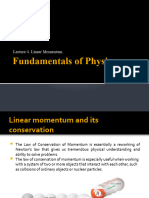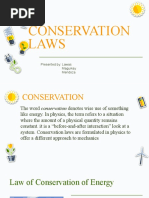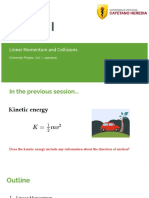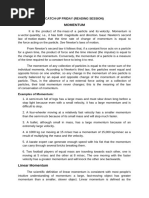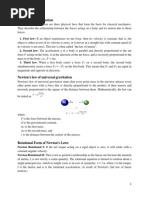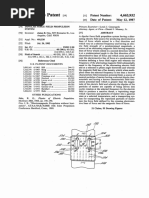Newton's Laws: Principle of Conservation of Momentum
Newton's Laws: Principle of Conservation of Momentum
Uploaded by
zahidahoseinCopyright:
Available Formats
Newton's Laws: Principle of Conservation of Momentum
Newton's Laws: Principle of Conservation of Momentum
Uploaded by
zahidahoseinOriginal Title
Copyright
Available Formats
Share this document
Did you find this document useful?
Is this content inappropriate?
Copyright:
Available Formats
Newton's Laws: Principle of Conservation of Momentum
Newton's Laws: Principle of Conservation of Momentum
Uploaded by
zahidahoseinCopyright:
Available Formats
Newton's Laws
Principle of Conservation of
Newton's First Law: A body will continue to remain Momentum
in its state of being - at constant velocity in a straight The Principle of conservation of momentum states
line or at rest - unless acted upon by an external that when two particles collide:
resultant force. total momentum before impact = total
Newton's Second Law: The resultant force a body momentum after impact
experiences is directly proportional to the rate of
change of momentum of the body, and acts in the
direction of the momentum change. This law is
commonly expressed in mathematics as
where is the resultant force acting on the body in
the direction of the acceleration, is the mass of the
body and is the acceleration of the body.
Newton's Third Law: If body A exerts a force on
body B, body B exerts a force of equal magnitude and
opposite direction on body A.
Linear Momentum
Momentum is a vector quantity given by the product of m1u1 + m2u2 = m1v1 + m2v2
its mass and its velocity.
Elastic collisions
In elastic collisions both kinetic energy and linear
p is the momentum in kg ms-1 or Ns
momentum are conserved. They do not exist in the
m is the mass in kg
real world but are idealised scenarios which physicists
v the velocity in ms-1
use to simplify the mathematical of models. For
example, in kinetic molecular theory, it is assumed
Deriving F=ma that the collisions between gas molecules are fully
By Newton's Second Law Force is equal to the rate of elastic. (Eliminating this assumption would make the
change of momentum. model fiendishly difficult to manipulate.)
In an elastic collision, the final and initial velocities of
Momentum is the product of mass and velocity. the colliding particles must satisfy two conditions:
If mass is constant this can be rewritten as:
is the rate of change of velocity or acceleration.
Solving for and we get:
Therefore when mass is constant:
Kinetic Energy is clearly not conserved in this type of
collision either.
Some rather elegant results emerge from these
Impulse
equations. For example, if the masses of both colliding
particles are equal, the particles 'exchange' velocities Impulse is the change in momentum of a body and is
upon impact. Furthermore, elastic collisions have the equal to the force applied to the body and the time for
property that which it acts.
That is to say, the relative velocity of one particle with
respect to the other is reversed by the collision and the
average of the momenta before and after the collision
is the same for both particles. Mathematicians may
view this simply as a generalization of Newton's law of
restitution (in the case where
Inelastic collisions
In an inelastic collision only linear momentum is
conserved. Kinetic energy is not conserved because as
the bodies collide they suffer energy losses in the form
of heat dissipation. Nevertheless total energy is always
conserved. Physically speaking, inelastic collisions are
the only type of collision that feature in reality.
Collisions in one dimension in which the particles
coalesce (merge after collision) are inelastic. In this
case, we can modify the conservation of momentum to
Superelastic Collisions (Explosions)
A body of mass is stationary and then
'explodes' to produce two bodies, masses and
moving in opposite directions with velocities and
. Alternatively, one is moving with velocity and the
other is moving with velocity . Mathematically:
You might also like
- A-Level-Physics MomentumDocument33 pagesA-Level-Physics MomentumleoNo ratings yet
- Newton's Law Note Physics IB HLDocument4 pagesNewton's Law Note Physics IB HLsupergirl123No ratings yet
- Impulse and Momentum For KALAMDocument15 pagesImpulse and Momentum For KALAMNordin fatihahNo ratings yet
- Further MechanicsDocument11 pagesFurther MechanicsBecky TenneyNo ratings yet
- Chapter 3Document7 pagesChapter 3Safeer aliNo ratings yet
- 3rd ChapterDocument11 pages3rd ChapterMushfiqur RahmanNo ratings yet
- Impulse, Momemtun 2Document3 pagesImpulse, Momemtun 2rkk34452No ratings yet
- 04 - Fundamentals of Physics - Naghi GasimovDocument17 pages04 - Fundamentals of Physics - Naghi GasimovKVP LyricsNo ratings yet
- Notes, Unit-4 and 5Document10 pagesNotes, Unit-4 and 5boyfrmhell37No ratings yet
- 3.5. Newton's Laws of Motion and MomentumDocument3 pages3.5. Newton's Laws of Motion and MomentumjmsonlNo ratings yet
- Elastic Collision - WikipediaDocument49 pagesElastic Collision - Wikipediawkagar17No ratings yet
- PHYSICS - Chapter 9Document69 pagesPHYSICS - Chapter 9Jaid HedrianaNo ratings yet
- 04. DYNAMICSDocument7 pages04. DYNAMICSkiliman0900000000No ratings yet
- Physics Module Week 7 and 8 V4 2024Document23 pagesPhysics Module Week 7 and 8 V4 2024JR BandelariaNo ratings yet
- PH110-CHAPTER 5 Linear Momentum and CollisionsDocument8 pagesPH110-CHAPTER 5 Linear Momentum and CollisionsNtape Knox SiwaleNo ratings yet
- 2858 Topper 21 110 2 4 322 2541 Newton S Laws of Motion Up201508051951 1438784483 8881Document4 pages2858 Topper 21 110 2 4 322 2541 Newton S Laws of Motion Up201508051951 1438784483 8881Ilaiya Maha LakshmiNo ratings yet
- BS Program Physics 2nd ClassDocument13 pagesBS Program Physics 2nd ClassjaivikNo ratings yet
- 04 Newtons Laws of MotionDocument20 pages04 Newtons Laws of MotionOjeaga FavourNo ratings yet
- Week 7Document32 pagesWeek 7christinereponte160No ratings yet
- Jassir A2 Notoes Physics EdexcelDocument2 pagesJassir A2 Notoes Physics EdexcelMahbub KhanNo ratings yet
- PDF - Js ViewerDocument3 pagesPDF - Js ViewerEmir Alam (11R)No ratings yet
- Newtonian MechanicsDocument1 pageNewtonian MechanicsDummy GoogleNo ratings yet
- Conservation of LawsDocument11 pagesConservation of LawsLadymie MantoNo ratings yet
- General Physics 1 Reviewer Cpe4Document15 pagesGeneral Physics 1 Reviewer Cpe4Fiona Marie100% (1)
- Lecture 5 - FBDsDocument24 pagesLecture 5 - FBDsjunedrkaziNo ratings yet
- DynamicsDocument26 pagesDynamicschimdesa TolesaNo ratings yet
- Note 2 PHY 111Document3 pagesNote 2 PHY 111mgp.beckybestNo ratings yet
- 2theme A.2 Forces and MomentumDocument57 pages2theme A.2 Forces and MomentumIMposter AmogUSNo ratings yet
- Horizontal Acceleration Is Zero Vertical Acceleratio: Mass VelocityDocument8 pagesHorizontal Acceleration Is Zero Vertical Acceleratio: Mass VelocityMaria Fe Mallari BañezNo ratings yet
- Idealization in MechanicsDocument2 pagesIdealization in MechanicsReashma Ps40% (5)
- PHYSICS 11TH GUESS AND IMPORTANT QUESTIONS FOR JKBOSE2025Document15 pagesPHYSICS 11TH GUESS AND IMPORTANT QUESTIONS FOR JKBOSE2025b87479006No ratings yet
- Dynamics Part 2Document6 pagesDynamics Part 2Ivan CapitoNo ratings yet
- Dynamics Lecture NotesDocument28 pagesDynamics Lecture NotesThanh ChươngNo ratings yet
- 17 Conservation of MomentumDocument23 pages17 Conservation of Momentumjames25235235235No ratings yet
- Laws of Motion 3 (C)Document4 pagesLaws of Motion 3 (C)Samrudh MysoreNo ratings yet
- H2 PHYSICS 6nd TEROTEDocument34 pagesH2 PHYSICS 6nd TEROTEMimaNo ratings yet
- Momento Lineal, Impulso-1Document26 pagesMomento Lineal, Impulso-1JIGGONINo ratings yet
- As Level Chapter 3 NotesDocument3 pagesAs Level Chapter 3 Notesl.dhesiganNo ratings yet
- Momentum - Is A Physics Term It Refers To The Quantity of Motion That An Object Has. Momentum Can Be Defined As "Mass in Motion."Document6 pagesMomentum - Is A Physics Term It Refers To The Quantity of Motion That An Object Has. Momentum Can Be Defined As "Mass in Motion."taneaturcu919No ratings yet
- Fisika Dasar - Buk Fitriyanti - Kuliah 03 - GayaDocument20 pagesFisika Dasar - Buk Fitriyanti - Kuliah 03 - GayaMUHAMMAD SALAFYNo ratings yet
- Newton's Law-1Document12 pagesNewton's Law-1siddiquigujjar551No ratings yet
- IMPORTANT QUESTIONS With Chapter SemiconductorDocument68 pagesIMPORTANT QUESTIONS With Chapter Semiconductorsonit1322No ratings yet
- General Physics l7Document4 pagesGeneral Physics l7Ronan CanavanNo ratings yet
- 6engineering Mechanics 1st Yr LMDocument11 pages6engineering Mechanics 1st Yr LMAkash Kumar Bhoi4004No ratings yet
- LINEAR MOMENTUM (READING SESSION)Document3 pagesLINEAR MOMENTUM (READING SESSION)Ian OrbeNo ratings yet
- Konservasi Energi: Nama: Viona Febrina NIM: 1405119196 Kelas: Fisika A1Document4 pagesKonservasi Energi: Nama: Viona Febrina NIM: 1405119196 Kelas: Fisika A1Viona FebrinaNo ratings yet
- Newton Laws of Motion PDFDocument5 pagesNewton Laws of Motion PDFTaylor Andres AmayaNo ratings yet
- Newton Laws of Motion: Trajectory - inDocument10 pagesNewton Laws of Motion: Trajectory - inpriyanka429No ratings yet
- Newton's Second Law: ImpulseDocument6 pagesNewton's Second Law: ImpulseRajeev DhimanNo ratings yet
- l1 and l2 - Unit I MechanicsDocument14 pagesl1 and l2 - Unit I MechanicsSivabharathi SivaNo ratings yet
- Chap 1 FundamentalsDocument17 pagesChap 1 Fundamentalsandersonjnr800No ratings yet
- Physics DefinitionsDocument15 pagesPhysics DefinitionsprintdaddyNo ratings yet
- General Physics I-4-2Document20 pagesGeneral Physics I-4-2tawhidalahi12345No ratings yet
- Center of Mass, Momentum, Impulse and Collision: Learning CompetenciesDocument7 pagesCenter of Mass, Momentum, Impulse and Collision: Learning CompetenciesNathalie SerafinNo ratings yet
- Laws of PhysicsDocument7 pagesLaws of PhysicsRinta MoonNo ratings yet
- 02 - Force and Lows of Motion - 43-66Document24 pages02 - Force and Lows of Motion - 43-66lenin.desoja.1985No ratings yet
- MomentumDocument18 pagesMomentumfadi kimyaNo ratings yet
- 3 Qdi ZPJKB 2 CBDF6 LV YG0Document21 pages3 Qdi ZPJKB 2 CBDF6 LV YG0G124Rohit MajiNo ratings yet
- PHY101 Laws of MotionDocument4 pagesPHY101 Laws of Motionfarouk jiyaNo ratings yet
- ReflectionsDocument2 pagesReflectionszahidahoseinNo ratings yet
- Forces: Mass Is Measured Using A Triple Beam Balance in A LabDocument1 pageForces: Mass Is Measured Using A Triple Beam Balance in A LabzahidahoseinNo ratings yet
- Scheme of Work Physics Lower 6Document2 pagesScheme of Work Physics Lower 6zahidahoseinNo ratings yet
- Vectors Pic QuestionDocument1 pageVectors Pic QuestionzahidahoseinNo ratings yet
- Gas Laws Form 4 Exercise and ExamplesDocument6 pagesGas Laws Form 4 Exercise and ExampleszahidahoseinNo ratings yet
- Cape Flyer 2018 2019Document1 pageCape Flyer 2018 2019zahidahoseinNo ratings yet
- Csec Flyer 2018 2019 FinalDocument1 pageCsec Flyer 2018 2019 FinalzahidahoseinNo ratings yet
- Scheme of Work U6 Physics 2020-2021Document16 pagesScheme of Work U6 Physics 2020-2021zahidahoseinNo ratings yet
- Form 3 Math Practice Test - Term 3Document3 pagesForm 3 Math Practice Test - Term 3zahidahosein67% (3)
- SOIL SCIENCE Concept MapDocument1 pageSOIL SCIENCE Concept MapzahidahoseinNo ratings yet
- Physics Mechanics Word SearchDocument1 pagePhysics Mechanics Word SearchzahidahoseinNo ratings yet
- Monday Tuesday Wednesday Thursday Friday SaturdayDocument1 pageMonday Tuesday Wednesday Thursday Friday SaturdayzahidahoseinNo ratings yet
- Quantum PhysicsDocument38 pagesQuantum PhysicsKrishna TripathiNo ratings yet
- LK3600 Radiation Survey MeterDocument2 pagesLK3600 Radiation Survey MeterfavouredcafebasicNo ratings yet
- IGCSE Cie Radiation P3Document9 pagesIGCSE Cie Radiation P3Payail Parineeta PalNo ratings yet
- (eBook PDF) Chemistry: The Central Science 13th Edition 2024 scribd downloadDocument41 pages(eBook PDF) Chemistry: The Central Science 13th Edition 2024 scribd downloadtakicpipia100% (2)
- Instant Access to Basic Concepts in Physics: From the Cosmos to Quarks 2nd Edition Masud Chaichian ebook Full ChaptersDocument65 pagesInstant Access to Basic Concepts in Physics: From the Cosmos to Quarks 2nd Edition Masud Chaichian ebook Full Chaptersbotsevzhaiyk100% (1)
- Hypoid Gears With Involute Teeth: David B. DoonerDocument6 pagesHypoid Gears With Involute Teeth: David B. DoonerLibardo Cardenas PNo ratings yet
- HTDocument101 pagesHTNandam HarshithNo ratings yet
- Electrical Manipulation of Semiconductor Spin Qubits Within The G-Matrix Formalism - RemovedDocument1 pageElectrical Manipulation of Semiconductor Spin Qubits Within The G-Matrix Formalism - RemovedAram ShojaeiNo ratings yet
- Lecture 5Document42 pagesLecture 5rosember_1995No ratings yet
- 10th Class Physics Chapter 10Document40 pages10th Class Physics Chapter 10ab88145wNo ratings yet
- Vehicle Tribology: Concept of WearDocument21 pagesVehicle Tribology: Concept of Wearjamesv52_743942786No ratings yet
- Full Download The Electronics Companion Devices and Circuits for Physicists and Engineers 2nd Edition Fischer-Cripps PDF DOCXDocument65 pagesFull Download The Electronics Companion Devices and Circuits for Physicists and Engineers 2nd Edition Fischer-Cripps PDF DOCXbanjitvaishu100% (1)
- Annachapter 6 SpectrosDocument44 pagesAnnachapter 6 Spectrosravi shankarNo ratings yet
- SAMPLE Exam2020-Hk1Document4 pagesSAMPLE Exam2020-Hk1Nam Anh Nguyễn HữuNo ratings yet
- CHAPTER I - Concept of Work Energy and PowerDocument2 pagesCHAPTER I - Concept of Work Energy and PowerEllaisa Molina Grabanzor0% (1)
- Berry ConnectionDocument6 pagesBerry ConnectionAshwin BalajiNo ratings yet
- Roll No 13 Phy Term 1 PaperDocument6 pagesRoll No 13 Phy Term 1 Papershamini sasikumarNo ratings yet
- TP-Minor Test-5-P-1-ENTHUSE-JEE-MAIN-25.10.2024-F1Document13 pagesTP-Minor Test-5-P-1-ENTHUSE-JEE-MAIN-25.10.2024-F1Nitya KhannaNo ratings yet
- Partial Differential Equations For Engin PDFDocument141 pagesPartial Differential Equations For Engin PDFمصطفى العباديNo ratings yet
- 21ESKEC001 Aakash Yadav 21ESKEC002 Aarohi Malsaria 21ESKEC003 Abhay Raj Shukla 21ESKEC004 Abhijeet Agarwal 21ESKEC005 Abhijeet GiriDocument12 pages21ESKEC001 Aakash Yadav 21ESKEC002 Aarohi Malsaria 21ESKEC003 Abhay Raj Shukla 21ESKEC004 Abhijeet Agarwal 21ESKEC005 Abhijeet GiriDiya SharmaNo ratings yet
- Tutorial IVDocument5 pagesTutorial IVnilayNo ratings yet
- Full download Elastic Waves in Solids 1 Propagation 1st Edition Daniel Royer pdf docxDocument47 pagesFull download Elastic Waves in Solids 1 Propagation 1st Edition Daniel Royer pdf docxviootapli100% (3)
- Dipolar Force Field Propulsion-04663932Document40 pagesDipolar Force Field Propulsion-04663932James parryNo ratings yet
- Optical Transmitter & Optical ReceiverDocument35 pagesOptical Transmitter & Optical ReceiverAnoop RajanNo ratings yet
- Spinel Ferrite Nanoparticles: Synthesis, Crystal Structure, Properties, and Perspective ApplicationsDocument21 pagesSpinel Ferrite Nanoparticles: Synthesis, Crystal Structure, Properties, and Perspective ApplicationsRicardo AGNo ratings yet
- J. Scheffel, P. Brunsell - Fusion Physics ExercisesDocument32 pagesJ. Scheffel, P. Brunsell - Fusion Physics ExercisesMário NY AmaroNo ratings yet
- Simple Harmonic MotionDocument7 pagesSimple Harmonic Motionpalakukey15No ratings yet
- B 2000 (Ovsyannikov) Plasma DiagnosticsDocument590 pagesB 2000 (Ovsyannikov) Plasma Diagnosticsutente489133No ratings yet
- General Physics 2 Module 1Document32 pagesGeneral Physics 2 Module 1GNC Tricia Faye DeleonNo ratings yet
- General Chemistry 2: Learning Activity SheetDocument33 pagesGeneral Chemistry 2: Learning Activity SheetKrismark IsraelNo ratings yet







